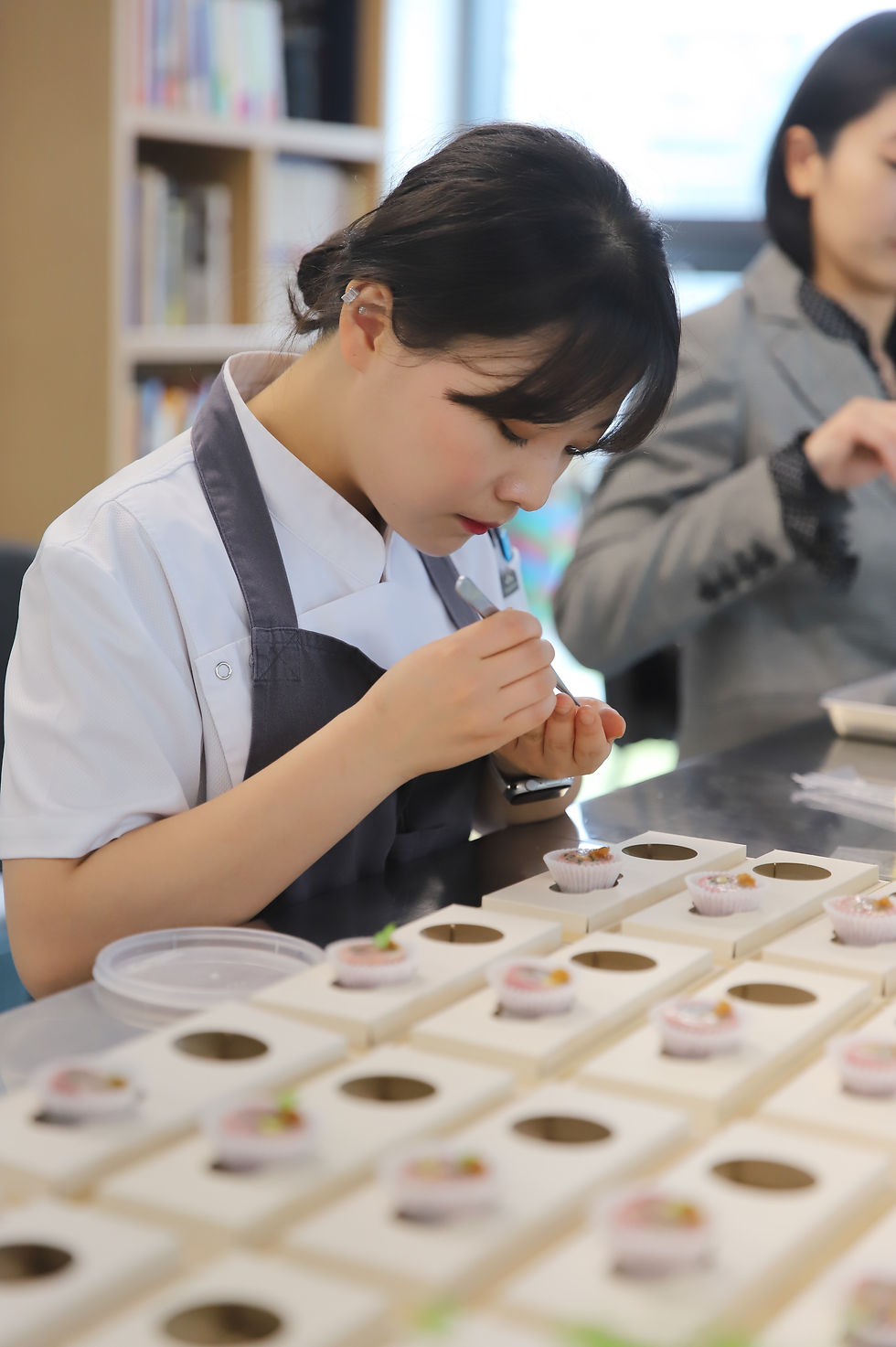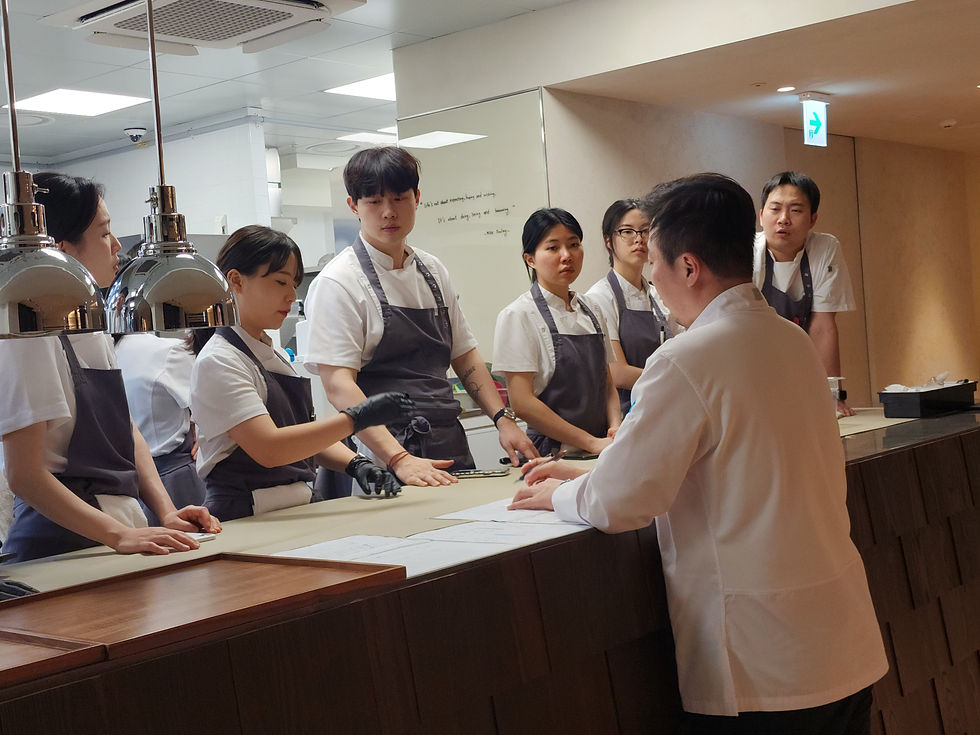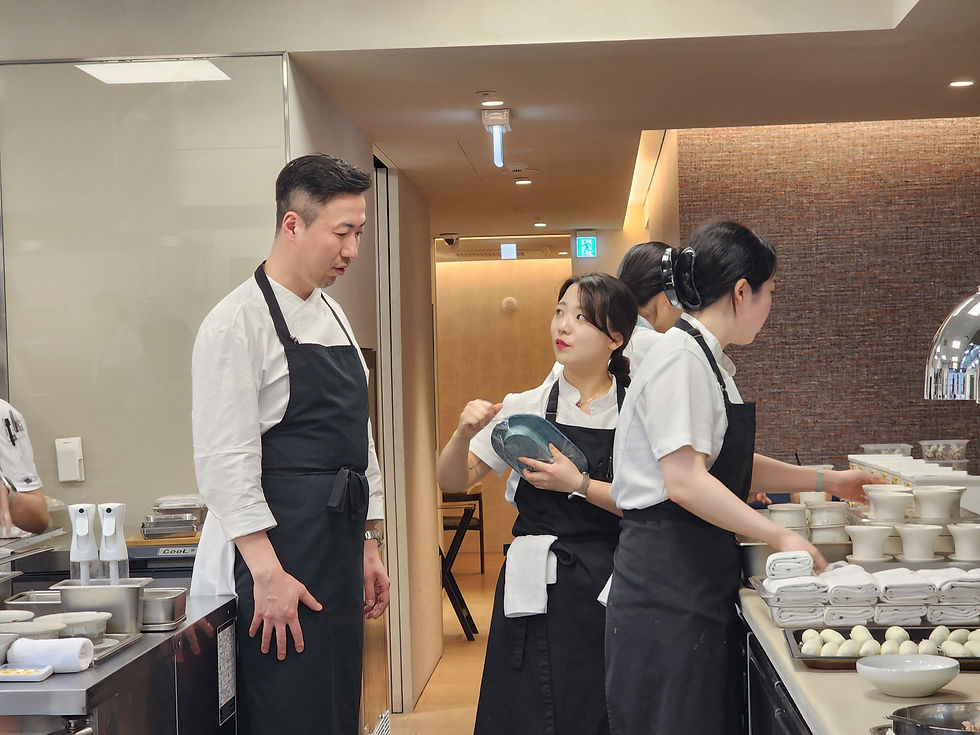Sous Chef: Eunjung Park
- solbam
- 8월 8일
- 8분 분량
최종 수정일: 9월 19일
This is the story of Sous Chef Eunjung Park, who, guided by Solbam’s identity as a ‘neo-classic Korean cuisine’ restaurant, researches Korea’s traditional food culture, leads her team, and devotes herself to daily service.

Can you tell us how you began cooking and what your journey has been like so far?
I didn’t set out to become a chef from the beginning. In fact, when I was younger, I was more interested in the fashion industry. I wanted to go to design school, but my grades weren’t good enough, so I had to give up on that dream. While looking into vocational high schools, I stumbled upon culinary arts—and that, I think, was the real start of my journey.
At first, I was interested in pastry and cocktails as well, but through my teacher’s recommendation, I began competing in international culinary competitions. Once I started, I completely fell in love with cooking. For about five years, my life revolved around competitions like those organized by WACS, and during that time, I realized how well cooking suited me. Of course, competition cooking is very different from restaurant cooking. In competitions, it’s about showcasing skills within a set time and theme, whereas in a restaurant, the focus is on overall harmony, consistent quality, and expressing the chef’s vision. Feeling that difference, I gradually wanted to focus more on hands-on restaurant experience, which naturally led me toward fine dining.
I still gained a lot from competing. My introverted personality changed, and I developed time management skills, recipe composition abilities, and organizational habits in cooking that continue to help me today. Especially at a young age, it’s rare to have the opportunity to design recipes independently, but the ingredient combinations I experimented with back then have become assets I still draw on now.

I hear you also have experience working front of house.
That’s right—I worked in service at TocToc for about a year. I’ve always had the desire to one day open my own restaurant, so I felt it was essential to understand the front-of-house perspective. Standing in the dining room taught me things I could never have learned in the kitchen—how guests react, how they enjoy their meals, how they view wine pairings. I also came to understand just how different the priorities are between the kitchen and the floor. Even now, I consider that time incredibly valuable, and I think more chefs should try it at least once.

What led you to join Solbam?
After my time in service, I spent three years cooking at Jungsik. Being a large and structured kitchen, there was so much to learn—especially since the divisions between stations were so well-defined, allowing me to focus deeply on fish and meat separately. While I was rethinking my path, I attended a pre-opening dinner at Solbam, and it completely shocked me. I had never experienced such a complete and harmonious flow to a meal. I thought, I have to work here. So I joined the team about three months after its official opening.
How has Solbam changed since you joined?
When I arrived, it was still in its early days, before everything was fully systematized. Chef Eom Tae-jun had already established a framework and standards, but much of our style emerged organically—shaped by the daily work, challenges, and each team member’s way of doing things.
Technically, I wasn’t part of the opening crew, but since I joined just two months after, I witnessed much of the restaurant’s formation and contributed to building its culture. Many of the people I worked with then are still here, which says a lot about our teamwork and atmosphere.

What would you say makes Solbam’s kitchen different from others you’ve worked in?
On the surface, most fine dining kitchens look similar in terms of systems, but when you get into the details, there are big differences. In the large kitchens I worked in before, roles were extremely segmented. Sometimes, a junior cook could work for a year and a half without ever touching prep for the hot station.
Solbam is different. While stations are divided, we interact and collaborate organically. We discuss and plate dishes together, so even junior cooks can experience a variety of dishes and workflows early on. This offers far more opportunities for growth. Of course, constantly rotating might raise concerns about depth in a single specialty, but we make up for that by supporting and complementing each other. I think this is a wonderful environment, especially for young chefs. It’s a structure we’ve built together, and I’m proud of that.

What has changed most for you since becoming sous chef?
Before, I was just responsible for a single station. As a sous chef, I’ve had to think more about relationships—how to treat people, how to guide them. I’ve learned a lot from Chef Eom in that regard.
In many kitchens, mistakes lead to a tense atmosphere, raised voices, and hurt feelings. Chef Eom takes a different approach—he tries to resolve things gently, through conversation. At first, I thought this took too much time compared to simply pointing out a mistake or raising your voice. But that’s only a short-term fix. In the long term, pressure and negativity can cause people to shrink, even making them lose skills they already had.
Chef Eom’s principle is to “maintain discipline without emotional drain.” I’ve learned a lot about leadership from that. After each service, we hold reviews to exchange feedback. At first, some people found it awkward, but over time, they adapted and even began to request feedback themselves. We try to focus on facts rather than emotions—that’s professionalism.

What’s something you’ve especially learned at Solbam?
I’ve learned how to plan a dish from start to finish. It’s not just about following a recipe, but conceptualizing a menu item, selecting the right serving ware, collaborating with artisans, and making it a reality.
We work on menus three months in advance. If we need new service ware, we meet with ceramicists or woodworkers to share our needs and understand their craft, adjusting designs accordingly. For example, our Hanwoo beef showing box initially had a sliding lid, but the wood warped from the heat when we added smoke. We added a metal plate, refined the finish, and redesigned the opening mechanism.
Another example is the Gaeridong abalone service cart we designed. We considered table height, guests’ eye level when the lid opens, and the most practical drawer structures—thinking through every detail. These experiences taught me that chefs design entire sensory experiences, not just food.

How have you developed your tasting skills?
I’ve learned so much from Chef Eom’s detailed approach to tasting. Every cook tastes their food, but pinpointing exactly what’s missing is another skill. If a dish needs more seasoning, is it salt, soy sauce, or umami? Chef Eom is excellent at identifying that, and it’s changed the way I think.
Since this is my first time as sous chef, I didn’t have someone coaching me directly. I made mistakes and learned by doing, always asking, “Why did this happen?” and trying a different approach next time.
What’s your most memorable moment with the team?
Without a doubt—the day we received our Michelin star. I had just gotten married and was leaving for my honeymoon, so I couldn’t attend the ceremony. Instead, my husband and I watched the livestream at the airport. The moment our name was called, it was incredibly moving. It felt like something our team had achieved together, not just me. That moment made our team spirit even stronger.

How does R&D work at Solbam?
The sous chefs take turns leading R&D. When a new seasonal menu launches, we start preparing the next one about a week later. We begin with research—reviewing menus from the same season in previous years, noting guest favorites or dishes with strong execution. Then we look for ways to develop those ideas further—changing cooking methods, reworking sauces, or trying entirely new ingredients.
As a neo-classic Korean cuisine restaurant, researching traditional Korean food culture is also key. For autumn, for example, we study seasonal ingredients and heritage dishes, then think about how to reinterpret them in Solbam’s style. This process involves close discussions with Chef Eom, and we refine garnishes and components through repeated testing until the menu is complete.

What has your overseas collaboration experience been like?
My first was with Nusara in Bangkok. None of us had prior experience with international collaborations, so we learned everything on the spot—what tools and serving ware to bring, how to adapt our work in a new environment. It was a huge learning experience.
Later, during a conversation with Jung Eun Park, owner-manager of NARO in New York, I learned that Central in Peru—then the world’s No. 1 restaurant—brings all its signature serving ware for overseas events. That made me realize that going abroad means meeting guests who can’t come to Seoul, so we should bring elements that represent our identity—our showing boxes, chopsticks, and unique service ware—to recreate the Solbam experience abroad.
We also learned about ingredient differences—for example, in Singapore, napa cabbage is much smaller, more like endive. You can’t anticipate everything, so each trip comes with unknowns, and flexibility is essential. Understanding the local market, produce, and food culture is just as important as cooking itself.

What challenges or goals are you aiming for now?
Recently, I joined a collaboration with Born in Singapore, and it made me think deeply about what it means to run a restaurant. It’s about much more than good food—interior design, storytelling, and brand identity are powerful elements. Seeing another restaurant from the outside also made me appreciate Solbam’s own strong narrative, design, and philosophy.
One day, I’d like to have my own restaurant, with my story clearly reflected in every detail. Right now, I’m exploring my identity and vision, thinking about what kind of restaurant I want to build.
In the near future, my biggest challenge is to take on a head chef role. As a line cook, my focus was on executing my tasks well; as sous chef, it’s been about operations, team management, and carrying out the missions given by Chef Eom. Now, I want to be the one who conceives the bigger picture, sets the direction, and drives it forward. I hope 2026 will be the year I take that first step.

And your long-term dream?
Since my husband is a sommelier, we’d like to run our own wine bar someday—a place with excellent food and wine, where the culinary side is as strong as the beverage program. I want to differentiate it through cooking techniques, ingredients, and attention to detail. My time at Solbam will help me continue building my culinary skills, while also gaining experience in managing people and operations so I can eventually run a business of my own.

What’s it like working in the same restaurant as your husband?
It’s both a blessing and a challenge. (Laughs) We communicate well, share the same interests, and understand each other’s work—so in that sense, there’s no friction. But it can also blur the line between work and personal life. Still, having the same days off is great for traveling together. We both love travel, and during COVID, we visited almost every region in Korea. One of our favorites was Andong—staying in a traditional house, enjoying the peaceful atmosphere, local drinks, and specialties. At the time, I never imagined I’d later end up at a restaurant so closely connected to Andong. (Laughs) More than anything, I hope Solbam continues to be loved for many years to come, and I’ll keep doing my best while pursuing my own dreams.



댓글